仲伟合《英语口译教程(上)》学习辅导书-第1~5章【圣才出品】
- 格式:pdf
- 大小:1.42 MB
- 文档页数:107
![仲伟合:英语口译教程[1]](https://uimg.taocdn.com/ef04491459eef8c75fbfb36a.webp)
第二部分练习篇Exercise OneListen to the following texts and then reproduce in the same language at the end of each segment:Text 1.1Mr Governor, Ladies and Gentlemen, It is my great pleasure to be invited to attend the Guangdong Governor’s International A dvisory Council Meeting.//I would like to take this opportunity to highlight our report to the Governor and share with you our view on the role of telecommunications and information infrastructure (ICT) in the economic development.//International experience suggests that Information and communication technology (ICT) infrastructure and services can have a substantial impact on the competitiveness of firms, nations, and regions. The most important impact of ICT does not come from manufacturing ICT goods, but from investing in and using ICT infrastructure and services.//According to the ITU, global telecommunications services sales reached US$ 1.1 trillion in 2002, more than three times the value of telecommunications equipment sales of US$335 billion.The value created by use of telecommunications services is estimated to be far higher than the total services revenue. Thus investment in ICT infrastructure creates value many times that of the investment itself. //Firm level studies show that ICT investments help firms gain competitiveness through improved efficiency, reduced inventories, better designs, and faster rates of innovation. ICT allows firms to increase the efficiency of their business processes by decreasing procurement and transaction costs, improving accounting and control, enhancing management systems, and streamlining their supply chains.//Several studies also indicate that ICT is a key driver of productivity and growth. There are several distinctive features of ICT that make them particularly important to national and regional economies, which include the pervasive and cross-cutting nature of ICT, the low or declining marginal costs of using the technologies, the ability to foster efficiency gains through streamlining supply chains, the facilitation of the creation of entirely new business models and industries, and the global nature of ICT.//All of these characteristics imply that ICT can have an important impact on competitiveness and economic development.//Text 1.2主席先生:我很高兴参加2001’国际投资论坛。
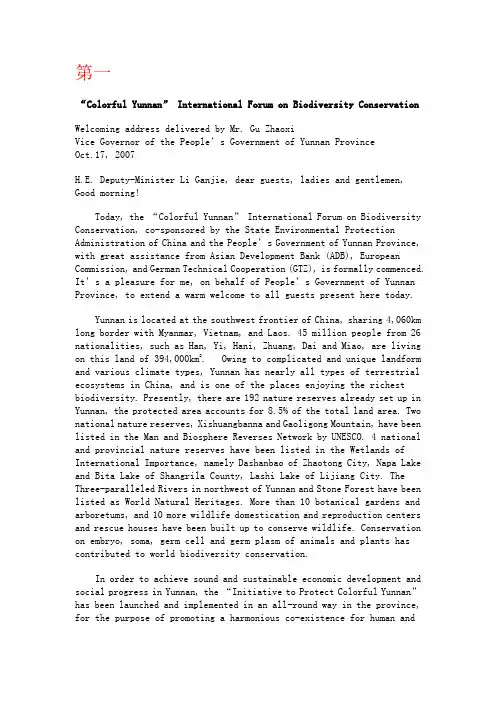
第一“Colorful Yunnan” International Forum on Biodiversity ConservationWelcoming address delivered by Mr. Gu ZhaoxiVice Governor of the People’s Government of Yunnan ProvinceOct.17, 2007H.E. Deputy-Minister Li Ganjie, dear guests, ladies and gentlemen, Good morning!Today, the “Colorful Yunnan” International Forum on Biodiversity Conservation, co-sponsored by the State Environmental Protection Administration of China and the People’s Government of Yunnan Province, with great assistance from Asian Development Bank (ADB), European Commission, and German Technical Cooperation (GTZ), is formally commenced. It’s a pleasure for me, on behalf of People’s Government of Yunnan Province, to extend a warm welcome to all guests present here today.Yunnan is located at the southwest frontier of China, sharing 4,060km long border with Myanmar, Vietnam, and Laos. 45 million people from 26 nationalities, such as Han, Yi, Hani, Zhuang, Dai and Miao, are living on this land of 394,000km2. Owing to complicated and unique landform and various climate types, Yunnan has nearly all types of terrestrial ecosystems in China, and is one of the places enjoying the richest biodiversity. Presently, there are 192 nature reserves already set up in Yunnan, the protected area accounts for 8.5% of the total land area. Two national nature reserves, Xishuangbanna and Gaoligong Mountain, have been listed in the Man and Biosphere Reverses Network by UNESCO. 4 national and provincial nature reserves have been listed in the Wetlands of International Importance, namely Dashanbao of Zhaotong City, Napa Lake and Bita Lake of Shangrila County, Lashi Lake of Lijiang City. The Three-paralleled Rivers in northwest of Yunnan and Stone Forest have been listed as World Natural Heritages. More than 10 botanical gardens and arboretums, and 10 more wildlife domestication and reproduction centers and rescue houses have been built up to conserve wildlife. Conservation on embryo, soma, germ cell and germ plasm of animals and plants has contributed to world biodiversity conservation.In order to achieve sound and sustainable economic development and social progress in Yunnan, the “Initiative to Protect Colorful Yunnan” has been launched and implemented in an all-round way in the province, for the purpose of promoting a harmonious co-existence for human andnature, and a well–coordinated development between socio-economy and environment.The opening of the forum will exert very positive and important influence on promotion of international cooperation, sustainable utilization and conservation on biodiversity. Let’s join our hands, admire the nature, protect our environment, promote our culture, and carry on the history!At last, on behalf of the People’s Government of Yunnan Province, please allow me to extend our sincere appreciation to SEPA, ADB, EC and GTZ, and to all institutes, organizations, and personnels from home and abroad who care and support environmental protection in Yunnan.I wish today’s forum a great success!I wish all guests good health, successful career and all the best!Thank you very much!第二Your excellency Premier Howard, Mr. Bizilj, ladies and gentlemen, friends:I am very happy with the Australian friends gather together here. Please allow me to Premier Howard's gracious hospitality, and take this opportunity, best wishes to the Australian people!In 1995 I visited your country, the visit left me a good impression. Again after 11 years here, I not only felt the friendly feelings towards the Chinese people and the people of Australia, but also found that the people here in China showed a keen interest in. People pay more attention to China, because China's reform and opening up has undergone tremendous changes. From 1978 to 2005,China's GDP increased by 11 times, according to the annual exchange rate, by$215300000000 to $2.2257; per capita GDP from $225 to $1707; last year,import and export trade amounted to $1.42; by February of this year, foreign exchange reserves reached $853*********.With China's overall national strength, the universal concern of the international community, China will take what kind of development path? Will assume what kind of responsibility to the international community? Can become a force for world peace and prosperity? I would like to talk about a few views thereon.China is taking a path of peaceful development. It is the essence of China,through striving for a peaceful international environment for its own development, but also to its own development to promote world peace; China's development depends on her own power and innovation, and adhere to the open policy; China to conduct exchanges and cooperation with all countries in the world on the basis of equality and mutual benefit, realize mutual benefit and win-win cooperation, common development. China's development is peaceful development, open development, cooperative development. Not to move or retreat to the path of peaceful development, is the inevitable choice for china.First, this is decided by China's historical and cultural traditions. The Chinese nation always have faith and promote good will, advocate of peace. "Do not do toothers,", "and not harm, to not fight," reflected the Chinese nation "the world offeelings and moral rationality" character.Second, this is determined by China's need for development. To accelerate the economic and social development, building a modern nation, is the Chinesepeople are striving for historical task. T o achieve this goal, we must live together in peace together, mutual trust with other countries.Third, this is decided by the tide of world development institute. The pursuit of peace, development, cooperation is the common aspiration of all peoples. Chinais a member of the international community, to achieve their own development, to conform to the world trend, together with other countries to take responsibility for safeguarding world peace.In short, adhere to the path of peaceful development, not a matter of expediency, but the Chinese government and people's serious choice and solemn commitment.Premier Howard said, China's development is conducive to China, but also conducive to the world. This reflects his understanding and support of China's peaceful development. Anyone without bias will see, China in the pursuit of their own development at the same time, is taking actions in the world to play a responsible role. Generally speaking, in the following ten aspects:-- China attaches great importance to the development of the social productive forces and improve the people's material and cultural life level, is committed to promoting the cause of human progress. China has successfully solved theproblem of feeding a population of 1300000000, lifted over 200 million people out of poverty, in the national basic universal compulsory education for 9 years,offers to help about 60000000 disabled people, providing equal development opportunities to all ethnic groups. Social stability at present China, people live and work in peace. China's development and stability is the biggest contribution to the world peace and prosperity.-- China through the summary of practical experience, has embarked on a road of scientific development. China insists to save resources, protect environmentas a basic national policy, strive to build a resource-saving, environment-friendly society, promote the comprehensive coordinated and sustainable economic and social development. China'sdevelopment will not pose a threat to the world.Stand on one's own -- China pursues peaceful foreign policy, his position is determined according to the right and wrong things itself. China adheres topursue peace, promote development of cooperation in international affairs,strictly abide by the Charter of the United Nations mission and universally recognized norms of international relations, not with other countries on the basis of ideology relationship, form alliance with any other country, in the five principles of peaceful coexistence and friendly countries.-- China firmly safeguarding world peace, is the international system participants,preserving and building. China joined over 100 inter governmental international organizations, signed nearly 300 international treaties. China actively promotes the establishment of a just and rational new international order, promote democracy in international relations, maintaining the diversity of world civilization.-- China adhere with neighbors, partnerships with neighboring countries, do a good neighbor, good partners. China through APEC, the Shanghai cooperation organization, China ASEAN cooperation, the Greater Mekong sub regional cooperation, promote the development of bilateral and regional cooperation, and promote common prosperity. We argue that regional cooperation should follow the principle of openness, strengthen ties with other countries and international organizations.China -- the peaceful resolution of disputes, plays a constructive role in addressing hotspot issues. China on the Korean nuclear issue, the Iranian nuclear issue, the Middle East and other major international consistentlynegotiations standpoint, non traditional security issues, including international cooperation actively to major natural disasters. Last year we hit on India Ocean tsunami in the implementation of the biggest international rescue operationhistory of china.-- China's active participation in counter-terrorism and non-proliferation cooperation, efforts to safeguard global security and strategic stability. China is opposed to terrorism, has played a constructive role in international anti-terrorism cooperation; China signed the "Treaty on the Non-Proliferation of nuclear weapons" and "Comprehensive Nuclear Test Ban Treaty", support the implementation of "biological weapons convention" and "Convention on the prohibition of chemical weapons", making the anti export control laws systemdiffusion comprehensive, and continue to strengthen law enforcement.-- China honors its WTO commitments, is committed to building a fair, free international trade system. After joining the WTO, China actively opening up the domestic market, the average tariff has dropped to 9.9%. The WTO trade in Services Division of 160 sectors and subsectors, China has pledged to open 100. China's intellectual property law mainly were further modified, so that therelevant agreements with the WTO consistent. China is also on the infringement of intellectual property rights lowered the threshold for criminal punishment,strengthen law enforcement for IPR protection.-- China earnestly implement the UN Millennium Development Goals, providedsincere and selfless assistance to developing countries. So far, China to more than 110 countriesand regional organizations with more than 2000 aid projects,for 44 underdeveloped countries reduced the debt of about 20000000000 yuan.In addition, China will in the next 3 years to underdeveloped countries provide us $10000000000 of preferential loans and preferential export buyer's credit, help them to strengthen infrastructure construction.-- China pursues a defensive national defense policy, to promote the cause ofinternational disarmament and arms control. China in the past 20 years, theabout 1700000. China's gross domestic product and the proportion of financial expenditure, in the world is relatively low. China's limited military spending growth, mainly to improve the military life, improve the defense ability andsafeguarding national unity, is not a threat to anyone. China's defense policy is transparent.China sincerely hopes to make greater contribution to world peace and prosperity. Therefore, China should accelerate the development of. Onlydevelopment, can China solve its own problems; only development, can Chinatake more responsibility in the world. Although China has made great progress,but it is still a developing country, facing heavy tasks of development.Population, underdeveloped productivity, development is not balanced, is China's basic national conditions. At present, China's per capita GDP is behindthe 100 world, China still has 23650000 poor people, need to solve thepopulation of nearly 24000000 jobs a year, there are about 60000000 disabled people need care and help, there are 1 hundred million rural labor force to transfer employment. To realize China's modernization, there is still a long way to go, need several generations, a dozen, or even dozens of generations of unremitting struggle.Ladies and gentlemen, friends:Peace and development are the common cause of all mankind, the building of a harmonious world is the common wish of the people around the world. Realize the human and human's harmony, the human and the natural harmony, peacebetween nations, need the joint efforts of the international community. Your former Prime Minister Mr. Menzies once warned: the struggle, searching,exploring, never give up! We are willing to cooperate with the international community including Australia, to build a harmonious world of enduring peace and common prosperity.Australia is rich in resources, developed economy and advanced technology,China has a market and development potential of large population, vast, a strong economic complementarity. At present, China is Australia's largest source of overseas students and fastest growing source of overseas tourists. Along with the establishment of China Confucius Institute in Australia second and "Chineseculture in Australia for" success, Australia humanistic contacts will be more closely. In Australia there is no conflict of fundamental interests, but have extensive common interests. The friendly and cooperative relations of long-term stability of the establishment of Australia, conforms to the fundamental interests of the two countries and two peoples. China Australia relations from a strategic point of view, is willing to work with Australia to become good friends, good partners.T oday, Prime Minister Howard and I held fruitful talks, reached broad consensuson developing comprehensive cooperative relations of mutual benefit and win-win in Australia in twenty-first Century. We agreed to strengthen politicalexchanges and strategic dialogue, enhance mutual trust, expand trade; ininvestment, energy, mineral resources and other areas of cooperation andaccelerating the China Australia FTA negotiations, achieve a win-win situation; to promote the culture, education, tourism and other exchanges, enhance mutual understanding and friendship between the people of regional cooperation;promote the healthy and orderly development, work together to maintainprosperity and stability in the Asia Pacific region. I believe, through the jointefforts of both sides, bilateral all-round cooperation relationship will certainly be fruitful!Now, I propose:Howard Prime Minister of health,As the two countries and the friendship between the two peoples,For the lofty cause of world peace and development,Bottoms up. (end)第三Let me begin by thanking you, Mr. Levin, for your kind invitation and the opportunity to come to Yale to meet young friends and teachers of thisworld-renowned university.Coming to the Yale campus, with its distinctive academic flavor, and looking at the eager young faces in the audience, I cannot but recall my great experience studying at Qinghua University in Beijing 40 years ago. Indeed, what happens during one’s school year will influence his whole life. I still benefit greatly from the instruction and my interaction with other students.Yale is renowned for its long history, unique way of teaching and excellence in academic pursuit. If time could go back several decades, I would really like to be a student of Yale just like you.Yale’s motto “Light and Truth,” which is a calling for human progress, represents the aspiration of every motivated young man and woman. Over the past three centuries, Yale has produced a galaxy of outstanding figures, including 20 Nobel laureates and five American presidents. The words of Nathan Hale, an American hero and Yale alumnus, “I only regret that I have but one life to lose for my country,”have also inspired me and many other Chinese. I sincerely hope that Yale will produce more talent and contribute further to the social and economic development of the United States and the cause of human progress.Ladies and gentlemen, dear friends,The Chinese and Americans have always had an intense interest in and cared deeply about each other. The Chinese admire the pioneering and enterprising spirit ofthe Americans and their proud achievement in national development. As China develops rapidly and steady headway is made in China-U.S. cooperation, more and more Americans are following with great interestChina’s progress and development.Understanding leads to trust. Today, I would like to speak to you about China’s development strategy and its future against the backdrop of the evolution of the Chinese civilization and China’s current development endeavor. I hope this will help you gain a better understanding of China.In a history that spans more than five millennia, the Chinese nation has contributed significantly to the progress of human civilization. But its course of national development has been an arduous one. In particular in the 160 years and more since the Opium War in 1840, the Chinese people have fought courageously and unyieldingly to rid themselves of poverty and backwardness and to realize national rejuvenation, thus profoundly changing the destiny of the Chinese nation. Ninety-five years ago, the Chinese people launched the Revolution of 1911 that overthrew the feudal autocracy which had ruled China for several thousand years and opened the door to China’s progress.Fifty-seven years ago, the Chinese people succeeded in winning liberation after protracted and hard struggle and founded New China in which people became their own masters. Twenty-eight years ago, the Chinese people embarked upon the historic drive of reform, opening-up and modernization and have made phenomenal progress through unremitting efforts.Between 1978 and 2005, China’s GDP grew from $147.3 billion to $2.2257 trillion. Its import and export volume went up from $20.6 billion to $1.4221 trillion and its foreign exchange reserve soared from $167 million to $818.9 billion. During this period, the number of its poor rural population dropped from 250 million to 23 million. The above review of the profound changes in these 160 years shows one thing, namely, by carrying out persistent and hard struggle, the Chinese people have both changed their own destiny and advanced the cause of human progress.On the other hand, I need to point out that, despite the success in its development, China remains the world’s largest developing country, with per capita GDP ranking behind the 100th place. The Chinese people are yet to live a well-off life andChina still faces daunting challenges in its development endeavor. Therefore it requires sustained and unremitting efforts to transform the country and make life better for its people. In the next 15 years, we will strive to make new progress in building a moderately prosperous society in an all-round way that will benefit China’s one billion and more population.We aim to raise China’s GDP to $4 trillion by 2020, averaging $3,000 per person. By then, China’s economy will be better developed and its democracy will be further enhanced. More progress will be made in science and education. Its culture will be further enriched, the society will become more harmonious and the people will lead a better life.To realize these goals, China has adopted a new concept of development in line with its national conditions and the requirement of the times. That is, to pursue ascientific outlook on development that makes economic and social development people-oriented, comprehensive, balanced and sustainable. We will work to strike a proper balance between urban and rural development, development among regions, economic and social development, development of man and nature, and domestic development and opening wider to the outside world. Greater emphasis will be put on addressing issues affecting people’s livelihood, overcoming imbalances in development and resolving key problems that have occurred in the course of development. We will pursue a new path to industrialization featuring high technology, good economic returns, low resource-consumption, low environment pollution andfull use of human resources. We will bring about coordinated economic, political, cultural and social development. And we will endeavor to ensure sustainable development by boosting production, improving people’s life and protecting the environment.This concept of scientific development is based on the experience China has gained in its modernization drive and put forth in response to the trends of the times. It is also rooted in the cultural heritages of the Chinese nation.The Chinese civilization is one that has continued uninterrupted for more than 5,000 years. The distinct cultural tradition of the Chinese nation that developedin the long course of history has exerted a strong influence on contemporary China, just as it did on ancient China. Putting people first, keeping pace with the times, maintaining social harmony and pursuing peaceful development: these values that are being pursued in China today are derived from its tradition. But they also give expression to the progress of the times.The Chinese civilization has always given prominence to the people and respect for people’s dignity and value. Centuries ago, the Chinese already pointed out that “people are the foundation of a country; when the foundation is stable, the country is in peace.” Nothing is more valuable in the universe than human beings. The ancient Chinese emphasized the value of serving the people, enriching them, nourishing them, and benefiting them. We are pursuing today a people-oriented approach toward development because we believe that development must be for the people and by the people and its benefit should be shared among the people.We care about people’s value, rights and interests and freedom, the quality of their life, and their development potential and happiness index because our goal is to realize the all-around development of the people. Ensuring the right to survival and development remains China’s top priority. We will vigorously promote social and economic development, protect people’s freedom, democracy and human rights according to law, achieve social fairness and justice and enable the 1.3 billion Chinese people to live a happy life.The Chinese civilization has always given prominence to unremittingself-improvement, reform and innovation. As an ancient Chinese motto puts it, “As Heaven keeps vigor through movement, a gentleman should unremittingly practice self-improvement.” Throughout its 5,000-year history, it is thanks to their perseverance, determination, stamina and innovation that the Chinese nation has grown after surviving numerous setbacks and adversity. The Chinese people haveshown enterprising spirit and reform and opening-up creativity in national development and great tenacity in overcoming difficulties on the road to progress. And all this gives expression to the spirit of unremitting self-improvement embodied in China’s cultural tradition.The Chinese civilization has always given prominence to social harmony, unity and mutual assistance. Back in the early days of the Chinese nation, the Chinese already advocated that “harmony is most valuable.” They strove for harmony between man and nature, among people and between man’s body and soul, and yearned for an ideal society where “everyone loves everyone else, everyone is equal and the whole world is one community.”Today, China is endeavoring to build a harmonious society. It is a society of democracy and rule of law, fairness and justice, integrity, fraternity, vitality, stability, order and harmony between man and nature. It is a society where there is unity between the material and the spirit, democracy and rule of law, fairness and efficiency, and vitality and order.The Chinese people takes [sic] the maintenance of ethnic unity and harmony as their bounden duty and the defense of the country’s sovereignty and territorial integrity their sacred mission.Any act that promoted ethnic harmony and national unity will receive the warm welcome and support of the Chinese people. On the other hand, any act that undermines China’s ethnic harmony and national unity will meet their strong opposition and resistance.The Chinese civilization has always given prominence to good neighborliness. The Chinese nation cherishes peace. In foreign relations, the Chinese have always believed that “the strong should not oppress the weak and the rich should not bully the poor” and advocated that “all nations live side by side in perfect harmony.”The Chinese held that “one should be as inclusive as the ocean, which is vast because it admits hundreds of rivers” and called for drawing upon the strength of others. Today, China holds high the banner of peace, development and cooperation. It pursues an independent foreign policy of peace and commits itself firmly to peaceful development.It seeks to accelerate its development by upholding world peace. The world peace is, in turn, enhanced by China’s development. China firmly pursues a strategy of opening-up for mutual benefit and win-win outcomes. It genuinely wishes to enter into extensive cooperation with other countries. It is inclusive and is eager to draw on the strength of other civilizations to pursue peace and development through cooperation and play its part in building a harmonious world of enduring peace and common prosperity.Ladies and gentlemen, dear friends,China and the United States are both countries of vast territory where many ethnic groups coexist and different cultures intermingle. Both our two peoples arehard-working and talented. Due to different historical backgrounds and national conditions, there are differences between China and the United States. But this enables us to learn from each other and draw on each other’s strengths. Closer China-U.S. cooperation serves the fundamental interests of our two countries and peoples and is also of far-reaching significance for peace and development of the whole world.Vast as it is, the Pacific Ocean has not stood in the way of exchanges and cooperation between our two peoples over the past two hundred years, and many moving episodes of mutual learning and mutual help between our two peoples who represent different civilizations have been recorded. In the 27 years since the establishment of diplomatic relations in 1979, China-U.S. relations have maintained steady momentum of growth despite twists and turns on the way, bringing tremendous benefits to both countries and peoples.Entering the 21st century, the world has continued to undergo profound changes. Peace and development remain the calling of our times. On the other hand, factors causing instability and uncertainty are increasing and new challenges and threats are looming. Against this backdrop, the common interests between our two countries are increasing and the areas of our cooperation widening. Global peace and security now face new challenges, such as fighting international terrorism, preventing the proliferation of weapons of mass destruction, protecting the environment and human habitat and combating transnational crimes. And it is exactly in these fields that we share important strategic interests. China has a huge market and its development has generated strong demand, while the United States has advanced technology and high quality products. This has created enormous opportunities for economic and technical cooperation between our two countries. Indeed, there is a broad prospect for the growth of constructive and cooperative China-U.S. relations in all fields.Yesterday morning, President Bush and I had an in-depth exchange of views on China-U.S. relations and major international and regional issues of common interest and reached broad and important agreement. We are both of the view that the two sides should approach our relations from the strategic and long-term perspective and that we should enhance dialogue, expand common ground, increase mutual trust, deepen cooperation and promote the overall growth of the constructive and cooperative China-U.S. relations in the 21st century.When we focus on the overall interest of China-U.S. relations, respect and show understanding to each other, I am confident that our relations will move ahead in a healthy and steady manner, and contribute to the well-being of our two peoples and bring greater hope to people around the world.Ladies and gentlemen, dear friends,A composer cannot write enchanting melody with one note, and a painter cannot paint landscape with only one color. The world is a treasure house where the unique cultural achievements created by people of all countries are displayed. The。
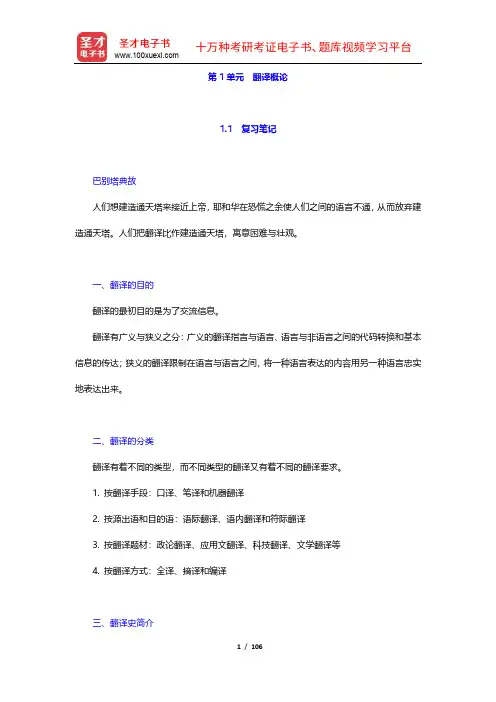
第1单元翻译概论1.1 复习笔记巴别塔典故人们想建造通天塔来接近上帝,耶和华在恐慌之余使人们之间的语言不通,从而放弃建造通天塔。
人们把翻译比作建造通天塔,寓意困难与壮观。
一、翻译的目的翻译的最初目的是为了交流信息。
翻译有广义与狭义之分:广义的翻译指言与语言、语言与非语言之间的代码转换和基本信息的传达;狭义的翻译限制在语言与语言之间,将一种语言表达的内容用另一种语言忠实地表达出来。
二、翻译的分类翻译有着不同的类型,而不同类型的翻译又有着不同的翻译要求。
1. 按翻译手段:口译、笔译和机器翻译2. 按源出语和目的语:语际翻译、语内翻译和符际翻译3. 按翻译题材:政论翻译、应用文翻译、科技翻译、文学翻译等4. 按翻译方式:全译、摘译和编译三、翻译史简介古代翻译多与宗教有关,西方翻译始于《圣经》,中国始于佛经的翻译。
西方翻译史中国翻译史四、翻译的标准翻译标准即指导翻译实践、评价译文质量的尺度。
翻译标准的确立对于建立科学的翻译理论体系具有重要的意义,而翻译的标准之争已形成“百家争鸣”之趋势。
1. 严复:信(faithfulness )、达(expressiveness )、雅(elegance )2. 鲁迅:信(faithfulness )、顺(smoothness )3. 林语堂:忠实(faithfulness )、通顺(smoothness )、美(beautifulness )4. 傅雷:神似(resemblance in spirit )主要阶段主要事迹 公元前3世纪中叶安德罗尼柯翻译了荷马史诗《奥德赛》 公元4~6世纪哲罗姆翻译了《通俗拉丁文本圣经》 公元11~12世纪 托莱多(阿拉伯语→拉丁文)公元14~16世纪 阿米欧翻译了《希腊罗马名人比较列传》查普曼翻译了《伊利亚特》和《奥德赛》弗罗里欧翻译了《散文集》英王詹姆士一世下令翻译了《钦定圣经译本》17世纪下半叶~20世纪上半叶 古典著作翻译热潮20世纪中叶~现在翻译范围、规模、作用直至形式大为改观 主要阶段主要特点 主要事迹 两汉至唐宋佛经翻译 玄奘、鸠摩罗什和真谛被誉为“我国三大佛经翻译家” 明末至清初 科技翻译 利马窦与徐光启合译了《几何原本》与《测量法义》鸦片战争至五四运动 西学翻译 林纾翻译了第一部小说《巴黎茶花女遗事》严复翻译了《天演论》《原富》等陈望道翻译了《共产党宣言》李达翻译了《政治经济学批判》建国初期至文革之前 东西方文学翻译 介译西方文学作品上世纪七十年代至今“翻译爆炸” 翻译队伍壮大、翻译领域广阔5. 钱钟书:化境(reaching the acme of perfection)6. 刘重德:信(faithfulness)、达(expressiveness)、切(closeness)7. 许渊冲:三重标准(three levels of criteria)8. 泰勒:翻译三原则(three principles of translation)9. 奈达:功能对等(functional equivalence)10. 纽马克:交际翻译与语义翻译(communicative and semantic translation)翻译标准的共核:忠实准确、通顺流畅和风格得体(三者顺序不可颠倒)。

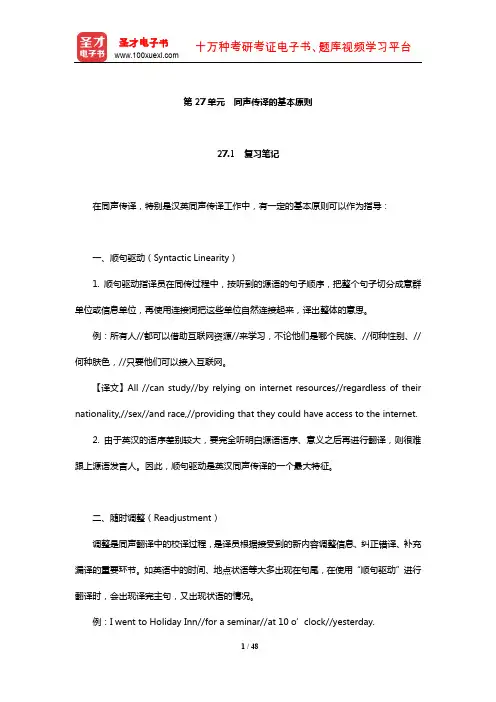
第27单元同声传译的基本原则27.1 复习笔记在同声传译,特别是汉英同声传译工作中,有一定的基本原则可以作为指导:一、顺句驱动(Syntactic Linearity)1. 顺句驱动指译员在同传过程中,按听到的源语的句子顺序,把整个句子切分成意群单位或信息单位,再使用连接词把这些单位自然连接起来,译出整体的意思。
例:所有人//都可以借助互联网资源//来学习,不论他们是哪个民族、//何种性别、//何种肤色,//只要他们可以接入互联网。
【译文】All //can study//by relying on internet resources//regardless of their nationality,//sex//and race,//providing that they could have access to the internet.2. 由于英汉的语序差别较大,要完全听明白源语语序、意义之后再进行翻译,则很难跟上源语发言人。
因此,顺句驱动是英汉同声传译的一个最大特征。
二、随时调整(Readjustment)调整是同声翻译中的校译过程,是译员根据接受到的新内容调整信息、纠正错译、补充漏译的重要环节。
如英语中的时间、地点状语等大多出现在句尾,在使用“顺句驱动”进行翻译时,会出现译完主句,又出现状语的情况。
例:I went to Holiday Inn//for a seminar//at 10 o’clock//yesterday.【分析】按顺句驱动的原则,可以这样译:“我去了假日酒店//参加一个研讨会//在十点钟//昨天。
”加上随时调整过程,这个句子在实际翻译中可能会译为:“我去假日酒店//参加了一个研讨会//时间是昨天上午十点。
”三、适度超前(Anticipation)适度超前是在源语信息还不完整的情况下,译员靠自己的语言能力、知识及临场经验预感到发言人可能要讲的内容而进行“超前翻译”,从而赢得时间,紧跟发言人进行同步翻译。
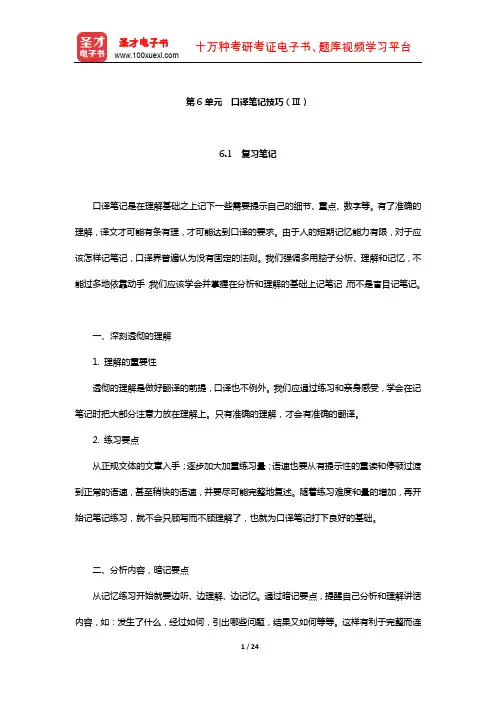
第6单元口译笔记技巧(Ⅲ)6.1 复习笔记口译笔记是在理解基础之上记下一些需要提示自己的细节、重点、数字等。
有了准确的理解,译文才可能有条有理,才可能达到口译的要求。
由于人的短期记忆能力有限,对于应该怎样记笔记,口译界普遍认为没有固定的法则。
我们强调多用脑子分析、理解和记忆,不能过多地依靠动手;我们应该学会并掌握在分析和理解的基础上记笔记,而不是盲目记笔记。
一、深刻透彻的理解1. 理解的重要性透彻的理解是做好翻译的前提,口译也不例外。
我们应通过练习和亲身感受,学会在记笔记时把大部分注意力放在理解上。
只有准确的理解,才会有准确的翻译。
2. 练习要点从正规文体的文章入手;逐步加大加重练习量;语速也要从有提示性的重读和停顿过渡到正常的语速,甚至稍快的语速,并要尽可能完整地复述。
随着练习难度和量的增加,再开始记笔记练习,就不会只顾写而不顾理解了,也就为口译笔记打下良好的基础。
二、分析内容,暗记要点从记忆练习开始就要边听、边理解、边记忆。
通过暗记要点,提醒自己分析和理解讲话内容,如:发生了什么,经过如何,引出哪些问题,结果又如何等等。
这样有利于完整而连贯地理解并掌握要译的内容。
有层次地去记笔记,也可以防止在口译时漏译。
如:原文:全国人民代表大会是中国的最高权力机关,行使立法权,任免权,决定权和监督权;国家主席是中国的元首,对内代表国家,对外代表政府,行使全国人大及其常务委员会赋予他的职权;国务院是中国的最高行政机关,它在全国人大授权之下行使行政权力;中央军事委员会是中国的最高军事领导机关,领导全国的武装力量;最高人民法院是中国的最高审判机关;最高人民检察院是中国的最高检察机关,与最高人民法院互相配合行使中国的司法权。
要点分析:这一段共有6点,是讲6个不同机构的性质和权力的。
如果在听的时候能抓住这一共同点,说明理解了,笔记也就可以越记越简单了。
笔记内容:三、注意框架和细节在理解的同时,除了抓住句子的主框架,即句子的主谓宾外,还要注意句子每一部分的细节,如重要的数字、时间、地点、人名、地名、机构名称等等。
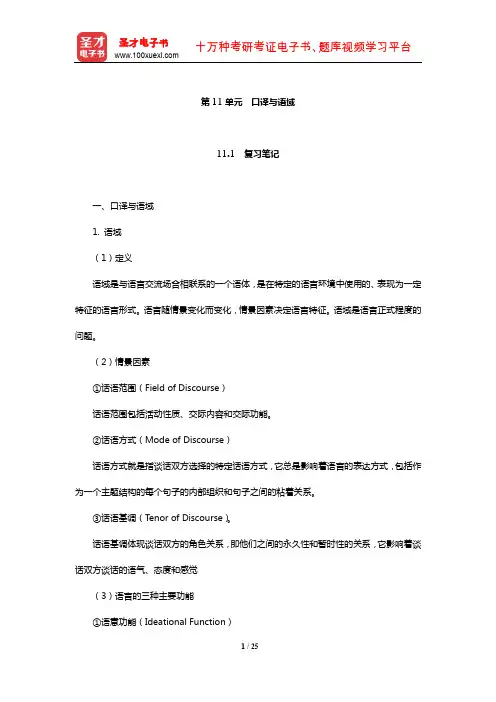
第11单元口译与语域11.1 复习笔记一、口译与语域1. 语域(1)定义语域是与语言交流场合相联系的一个语体,是在特定的语言环境中使用的、表现为一定特征的语言形式。
语言随情景变化而变化,情景因素决定语言特征。
语域是语言正式程度的问题。
(2)情景因素①话语范围(Field of Discourse)话语范围包括活动性质、交际内容和交际功能。
②话语方式(Mode of Discourse)话语方式就是指谈话双方选择的特定话语方式,它总是影响着语言的表达方式,包括作为一个主题结构的每个句子的内部组织和句子之间的粘着关系。
③话语基调(Tenor of Discourse)。
话语基调体现谈话双方的角色关系,即他们之间的永久性和暂时性的关系,它影响着谈话双方谈话的语气、态度和感觉(3)语言的三种主要功能①语意功能(Ideational Function)语意功能组织说话人或写作者的真实世界或虚幻的人、事物、行为、事件、状态等。
②人际功能(Interpersonal Function)人际功能表达、建立或保持人们的社会关系,包括称谓形式、言语功能形式、情态等。
③篇章功能(Textual Function)篇章功能形成连贯的、与特定使用场合相吻合的书面或口头的语段。
2. 口译与语域的关系口译应掌握语言的语域等级问题,即语言正式程度的问题。
一方面,要在语言形式上符合目的语的表达规范,尽可能保持信息的“原汁原味”;另一方面,还应在内容上保持信息的完整性,从而最终能准确无误地表达出来。
做到什么样的场合该用什么样的表达方式,最终使双方都能接受。
例如:原文:The proceedings of the General Assembly in respect of matters brought to its attention under this Article will be subject to the provisions of Articles 11 and 12.The original Members of the United Nations shall be the states which, having participated in the United Nations Conference on International Organization at San Francisco, or having previously signed the Declaration by United Nations of 1 January 1942, sign the present Charter and ratify it in accordance with Article 110.译文:大会关于按照本条所提请注意事项之进行步骤,应遵守第11条及第12条之规定。
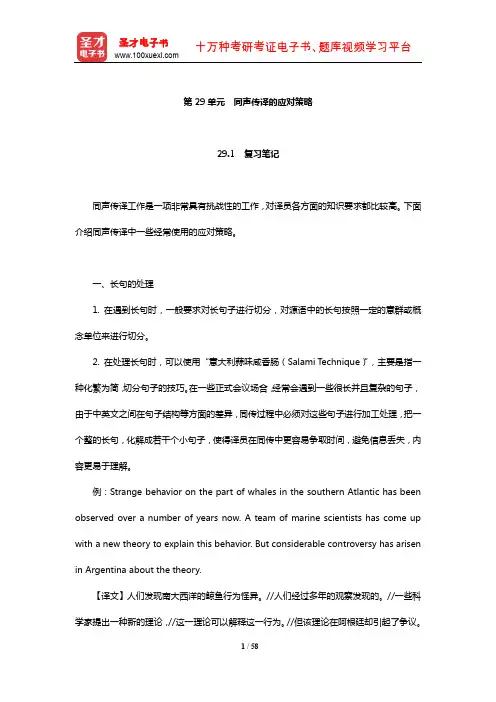
第29单元同声传译的应对策略29.1 复习笔记同声传译工作是一项非常具有挑战性的工作,对译员各方面的知识要求都比较高。
下面介绍同声传译中一些经常使用的应对策略。
一、长句的处理1. 在遇到长句时,一般要求对长句子进行切分,对源语中的长句按照一定的意群或概念单位来进行切分。
2. 在处理长句时,可以使用“意大利蒜味咸香肠(Salami Technique)”,主要是指一种化繁为简,切分句子的技巧。
在一些正式会议场合,经常会遇到一些很长并且复杂的句子,由于中英文之间在句子结构等方面的差异,同传过程中必须对这些句子进行加工处理,把一个整的长句,化解成若干个小句子,使得译员在同传中更容易争取时间,避免信息丢失,内容更易于理解。
例:Strange behavior on the part of whales in the southern Atlantic has been observed over a number of years now. A team of marine scientists has come up with a new theory to explain this behavior. But considerable controversy has arisen in Argentina about the theory.【译文】人们发现南大西洋的鲸鱼行为怪异。
//人们经过多年的观察发现的。
//一些科学家提出一种新的理论,//这一理论可以解释这一行为。
//但该理论在阿根廷却引起了争议。
3. 处理长句还要学会使用“润滑剂”。
由于在同声传译时,为了赶时间,译员往往尽可能依照原文的句法结构,即前面介绍的“顺句驱动”方法,避免做大的改动。
当把长句切为短句时,难免会造成一种断断续续、互不关联的感觉。
因此,在短句之间,要灵活地添加一些虚词。
这些词本身不具有任何意义,但却能使译出的句子听起来不那么艰涩、生硬。
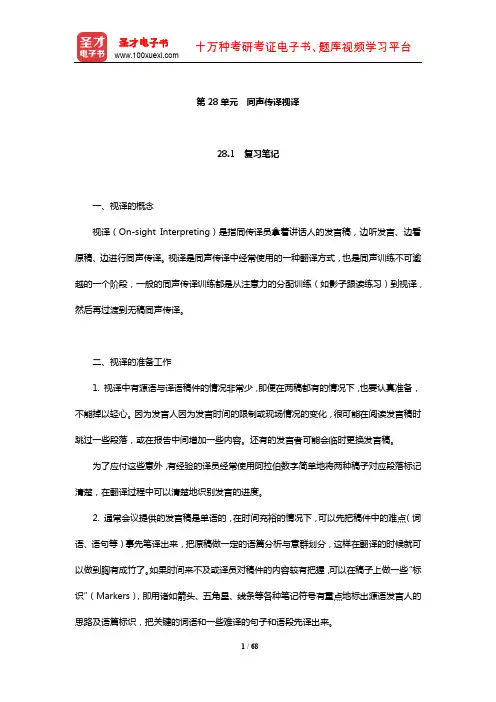
第28单元同声传译视译28.1 复习笔记一、视译的概念视译(On-sight Interpreting)是指同传译员拿着讲话人的发言稿,边听发言、边看原稿、边进行同声传译。
视译是同声传译中经常使用的一种翻译方式,也是同声训练不可逾越的一个阶段,一般的同声传译训练都是从注意力的分配训练(如影子跟读练习)到视译,然后再过渡到无稿同声传译。
二、视译的准备工作1. 视译中有源语与译语稿件的情况非常少,即便在两稿都有的情况下,也要认真准备,不能掉以轻心。
因为发言人因为发言时间的限制或现场情况的变化,很可能在阅读发言稿时跳过一些段落,或在报告中间增加一些内容。
还有的发言者可能会临时更换发言稿。
为了应付这些意外,有经验的译员经常使用阿拉伯数字简单地将两种稿子对应段落标记清楚,在翻译过程中可以清楚地识别发言的进度。
2. 通常会议提供的发言稿是单语的,在时间充裕的情况下,可以先把稿件中的难点(词语、语句等)事先笔译出来,把原稿做一定的语篇分析与意群划分,这样在翻译的时候就可以做到胸有成竹了。
如果时间来不及或译员对稿件的内容较有把握,可以在稿子上做一些“标识”(Markers),即用诸如箭头、五角星、线条等各种笔记符号有重点地标出源语发言人的思路及语篇标识,把关键的词语和一些难译的句子和语段先译出来。
3. 在原稿并无参考价值的情况下,可以忽略原稿,把精力集中在无稿同声传译的技术工作中,利用口译笔记等,进行无稿同传。
口译的视译准备工作有时要在口译厢中进行,译员可以事先准备好词典,对那些较难的重要信息进行一定程度的准备。
4. 译员在准备过程中如果发现讲稿存在实在难以理解、过于深奥或冷僻的地方,在时间允许的情况下,最好能请教一下演讲人或有相关专业知识的人。
在国际会议中,译员对于特殊的观念、思想、概念等,一定要虚心请教,不能望文生意。
三、视译的训练1. 初步练习可以找一些有译文的发言稿,边听发言录音,边做“同声传读”。
然后逐渐过渡到脱离译稿,只看原文进行口译。
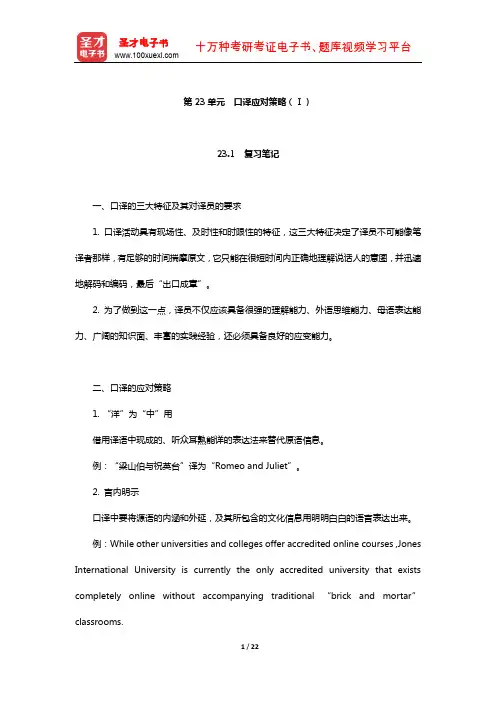
第23单元口译应对策略(Ⅰ)23.1 复习笔记一、口译的三大特征及其对译员的要求1. 口译活动具有现场性、及时性和时限性的特征,这三大特征决定了译员不可能像笔译者那样,有足够的时间揣摩原文,它只能在很短时间内正确地理解说话人的意图,并迅速地解码和编码,最后“出口成章”。
2. 为了做到这一点,译员不仅应该具备很强的理解能力、外语思维能力、母语表达能力、广阔的知识面、丰富的实践经验,还必须具备良好的应变能力。
二、口译的应对策略1. “洋”为“中”用借用译语中现成的、听众耳熟能详的表达法来替代原语信息。
例:“梁山伯与祝英台”译为“Romeo and Juliet”。
2. 言内明示口译中要将源语的内涵和外延,及其所包含的文化信息用明明白白的语言表达出来。
例:While other universities and colleges offer accredited online courses ,Jones International University is currently the only accredited university that exists completely online without accompanying traditional “brick and mortar”classrooms.【译文】虽然其它大学也提供经认证的在线课程,但是Jones国际大学则是目前完全存在于网上、完全没有传统(“砖瓦型”)教室的唯一一所获得认证的大学。
【分析】从上下文语境中,我们不难发现,其实所谓的“‘brick and mortar’classrooms”(“砖瓦水泥型”教室)指的是具有物理形态的传统教室,因为它不同于网络学校所开设的“虚拟教室”(virtual classrooms)。
有了这一层理解后,整句话就不难理解了。
3. 以“图”代“言”这一应变策略尤其适用于科技或商务类口译,这类口译本身的难度并不大,难点在于概念的解释和专业术语的运用。
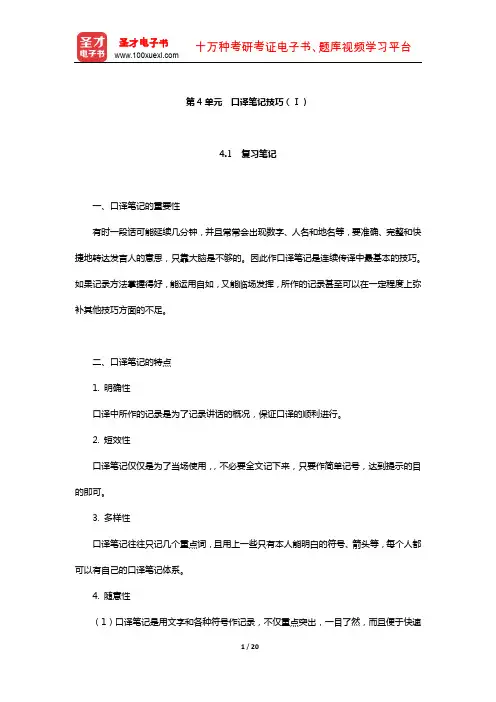
第3单元演讲技巧3.1 复习笔记口译与笔译的最大区别之一,就在于口译工作者更为“可见”。
站在大庭广众之中,于众目睽睽之下开口讲话,十分不易。
因此,对于一个成功的口译工作者来说,掌握扎实的演讲技巧是根本要务。
一、熟悉讲话场所,增强演讲效果1. 观察发言人所处的房间设施情况,屋顶的高低、窗帘的厚度、房间的面积等都会对音效造成影响。
2. 发言人需要对多少观众讲话,是在讲台上发言还是流动讲话。
3. 对于译员本人来说,是站在讲话人身边还是退到舞台一侧。
4. 有没有辅助工具(如麦克风),是有支架的麦克风、手持无线麦克风还是便携式无线麦克风。
要注意调试麦克风,以免出现音质有问题或电池电量不够的尴尬场面。
二、综合运用演讲的几大要素音量(Volume):在翻译过程中应适时调节音量,观察听众表情确认音量是否合适。
译员切勿大声喊叫,即使是发言人声音过大,也不可受到影响而提高音量。
适中的音量既使自己的翻译容易被听众接受,也不会显得信心不足或喧宾夺主。
音调(Pitch):一般来说,译员在翻译中最好采用中音,因为中音显得沉稳可信,并应注意通过音调的变化让听众感受到友好、温和、诚恳和热情。
然而,这绝不意味着译员应自始至终使用一种音调,单调不变的音调会使听众感到沉闷,极大地破坏演讲效果。
节奏(Rate):讲话人声音传递的速度快慢。
虽然译员应该考虑所翻译的内容特点和讲话人所采用的速度而确定自己翻译传达的节奏,但在平均值上下浮动幅度过大,会造成听众接受信息的额外负担。
因此,译员应采用中等速度,而且在重要信息点,如数字、专门用语、人名、头衔等和讲话人特别强调的关键词上应将速度适当放慢。
在翻译过程中经常调整节奏也十分重要。
停顿(Pauses):对于译员来说,适当停顿既能够自然大方地创造时间进行思考或修补翻译中的缺陷,又能够为信息表达带来更为出色的效果。
译员应该注意掌握停顿的时间,过长的停顿会让听众认为是译员翻不出来,从而影响他们对译员的信任;而过短的停顿又起不到什么作用。
第7单元联络口译7.1 复习笔记一、联络口译联络口译又称联络陪同口译。
联络陪同口译的任务就是在接待、旅游等事务中担任口译工作。
二、联络口译的要求1. 强烈的责任感①接到联络口译任务后,准确把握工作的时间和场所,做到心中有数②在口译工作之前进行大量的细致准备,了解接待客人的身份、爱好、特点等背景信息和客人活动的内容等。
2. 百科全书般的渊博知识联络口译中涉及到的内容往往比会议口译更为随意和灵活。
例如,在双方共进晚餐的时候,所进行的谈话几乎完全是随机的,上至天文、下至地理,无所不包,译员不太可能对讲话内容做出先期准备。
在这种情况下,译员的知识面显得非常重要。
3. 跨文化交际意识文化因素,包括宗教、家庭、传统、价值观等,决定人们如何行动和如何适应环境。
不重视跨文化交际意识的培养,经常会导致口译工作的失误,甚至带来很严重的后果。
范例:①慢走√Bye! Have a good day.×Walk slowly.②——啊!你做的菜真好吃!——哪里哪里,一点也不好吃!√——You made fantastic dishes! ——Thank you! I hope you enjoyed it.×——You made fantastic dishes! ——No, it’s not delicious at all.③此门不通√Please use the other door×No entry through this door④这没什么,是我应该做的√Thank you for your kind words.×It’s nothing/This is what I should do.7.2 实例详解Exercise 2The following exercise is for you to practice liaison or dialogue interpreting. Divide the class into 3-party groups, each with 3 students playing the 3 different roles. The first party plays the role of an English-speaking person. The second plays the part of a Chinese-speaking person. The third acts as an interpreter. As the dialogue goes on, the student interpreter does the interpreting two ways at the end of each segment. After one round, students in each group may change roles and dothe practice again.Visiting Guangzhou University TownParticipants:1. Mr. Chen, Director of the International Office, Guangdong Higher Education Department2. Mr. Johnson, representative of the British Council, London3. InterpreterScenario:You have been asked to interpret on behalf of Guangdong Higher Education Department, who is receiving a guest from the British Council in the UK on a trip to the newly-established Guangzhou Higher Education Mega Center (Guangzhou University Town) ...陈主任:约翰逊先生,我们现在已经进入广州大学城了。
第16单元译员的素质要求16.1 复习笔记要成为一名优秀的译员,至少应具备下面的基本素质:一、“时刻准备着”的责任心译员平时做好一切心理及技术操作上的准备,培养“时刻准备着”的高度责任感,能随时随地以最佳状态迎接并完成口译任务。
二、扎实的语言基本功1. 精通两种语言(源语和目的语)(1)作为一名译员,要不断学习、善于总结,努力掌握源语和目的语各自的特点和双语互译的变化规律,使目的语的表达更贴近源语。
(2)明确中英两种语言在表达上的不同特点:汉语喜欢用含蓄、模糊的用语来强调客气;而英语多用清晰、明白、富有逻辑的表达。
汉语是分析性语言,重意合,多话题句和无主句;英语兼有分析性和综合性,讲究形合,重语言形式,连接手段完善。
2. 优秀的听说和笔记技能(1)听力是口译活动的前提和基础,听准记牢至关重要。
因此,平时多注意进行逻辑训练,培养综合理解能力,熟悉“同步笔记”,抓住大意和主题,力争做到长句能抓住要点,数字能准确记住并表达,从而提高口译质量。
(2)口译笔记是为了临时应用,只需将主要内容、转折点、关键词或未弄懂的地方记下来即可,大多数内容还要靠大脑来临时记忆。
做笔记时,译员切不可用速记的方式,因为在短暂的瞬间可能难以迅速而准确地解读速记内容,译员必须用直观、清楚的表达,易于自己快速辨认。
做笔记用英文还是用中文,这因人而异,但通常多用母语记更合适。
3. 发音标准和语音流畅(1)语音准确明白是口译的第一要求,语调优美、语音流畅也是高质量的口译人员所应具备的素质之一,作为口译人员应力求做到发音标准,包括准确的单词重音、句子重读及升降调等。
(2)好的译员表达出来的译文应如发言人一样流畅。
要尽可能保持原话的风格,并在措辞、口音、语气方面尽量保持自然,不矫揉。
翻译的语调也要保持适中,根据不同场合,照顾到观众的情绪,使用得体的语调。
三、百科全书般的知识译员应博览群书,平时一定要做准备工作,了解相关背景材料以及会谈内容,做到有备而来。
Unit 1李颖:We are going to ascend the great wall tomorrow morning. So I’d like to go to bed early and have a good sleep this evening. You know climbing the great wall is not an easy job.明天早上我们计划去爬长城,所以我想今晚早点休息,好好睡一觉。
你知道爬长城可不是一件简单的事情。
Jack: Great. The Great Wall is very famous and becomes a must for tourist in Beijing. Would you tell me something about it好啊。
长城那么有名,是游客来北京必去的景点。
你能和我说一说长城么李颖:OK. The construction of the great wall took altogether over started in the Zhou dynasty in the 7th century. . And continued until Ming Dynasty in the 15th century . The existing wall was built in the Ming Dynasty.好。
长城的整个建筑过程持续了总共两千多年,始于公元七世纪的周朝,后来一直延续到公元后十五世纪的明朝。
现存的城墙都是明朝修建的。
Jack: The Great Wall is indeed the crystallization of the industry and wisdom of the Chinese people and also a symbol of ancient Chinese culture. Then why the ancient people built the wall长城的确是中国人民勤劳智慧的结晶,同时也是中国古代文化的象征.那么为什么古代人民要修建长城呢李颖:It was constructed to guard against the invasion by nomadic tribes from the north. When enemy troops approached, guards on watch would send smoke signals from the beacon-fire towers as an alarm.修建长城是为了抵御来自北方游牧民族的入侵。